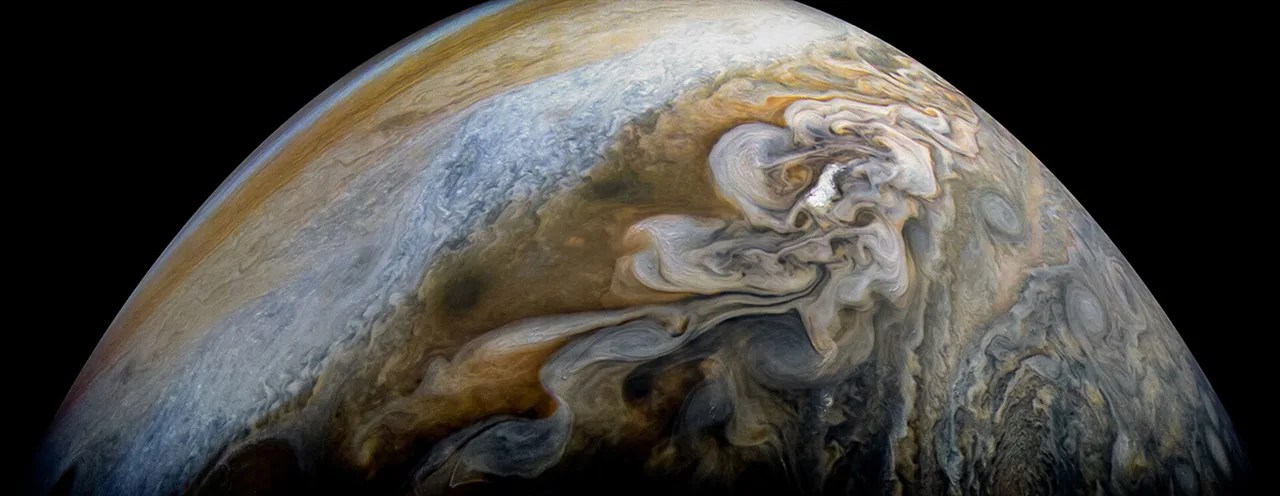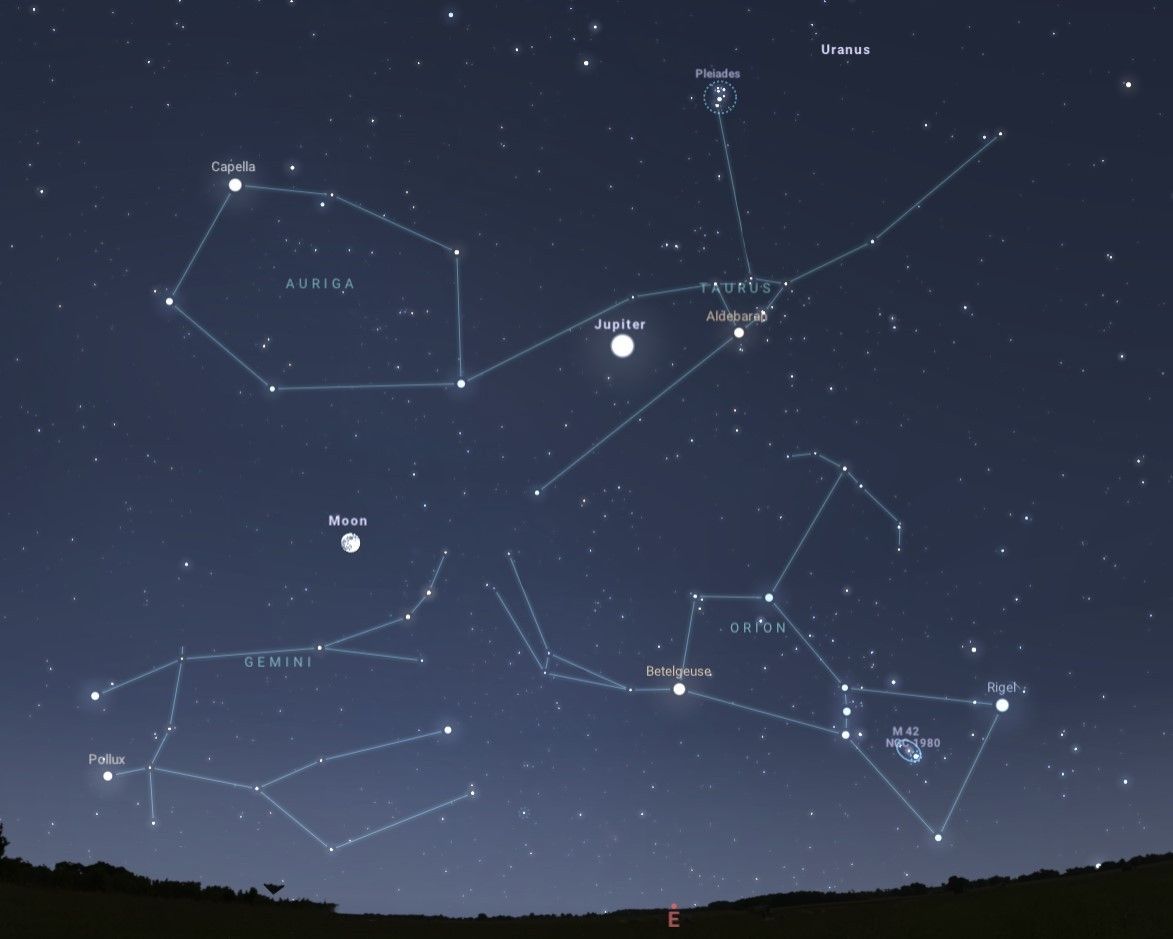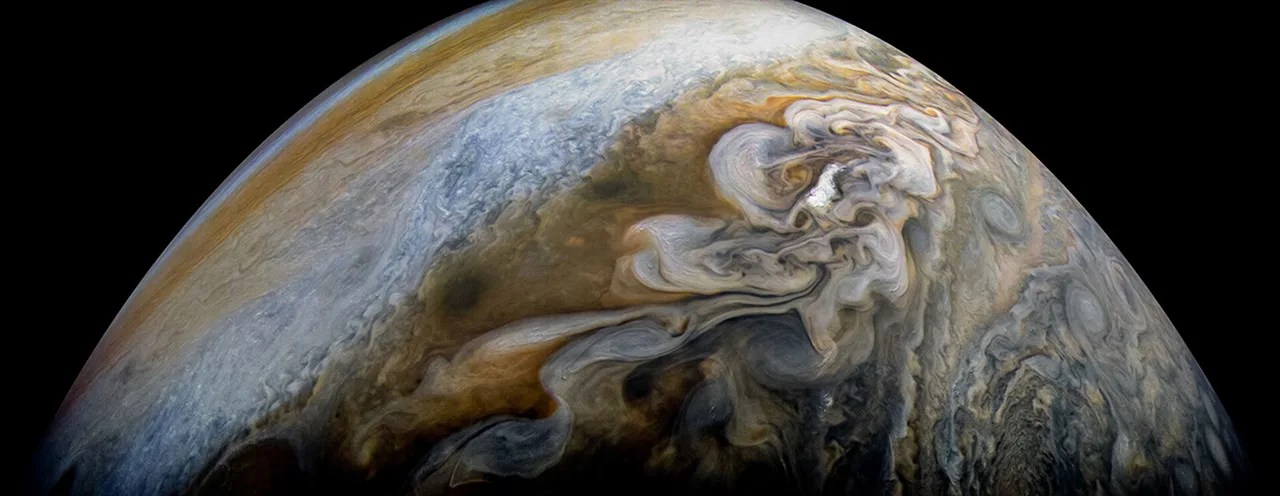4 min read
December’s Night Sky Notes: Spot the King of Planets by Kat Troche of the Astronomical Society of the Pacific
Jupiter is our solar system’s undisputed king of the planets! Jupiter is bright and easy to spot from our vantage point on Earth, helped by its massive size and banded, reflective cloud tops. Jupiter even possesses moons the size of planets: Ganymede, its largest, is bigger than the planet Mercury. What’s more, you can easily observe Jupiter and its moons with a modest instrument, just like Galileo did over 400 years ago.
 This image taken on Feb. 7 by NASA’s Juno spacecraft, reveals swirling cloud formations in the northern area of Jupiter’s north temperate belt. Citizen scientist Kevin M. Gill processed the image using data from the JunoCam imager. NASA, JPL-Caltech, SwRI, MSSS | Image processing by Kevin M. Gill, © CC BY Jupiter’s position as our solar system’s largest planet is truly earned; you could fit 11 Earths along Jupiter’s diameter, and in case you were looking to fill up Jupiter with some Earth-size marbles, you would need over 1300 Earths to fill it up – and that would still not be quite enough! However, despite its formidable size, Jupiter’s true rule over the outer solar system comes from its enormous mass. If you took all of the planets in our solar system and put them together, they would still only be half as massive as Jupiter all by itself. Jupiter’s mighty mass has shaped the orbits of countless comets and asteroids. Its gravity can fling these tiny objects towards our inner solar system and also draw them into itself, as famously observed in 1994 when Comet Shoemaker-Levy 9, drawn towards Jupiter in previous orbits, smashed into the gas giant’s atmosphere. Its multiple fragments slammed into Jupiter’s cloud tops with such violence that the fireballs and dark impact spots were not only seen by NASA’s orbiting Galileo probe but also by observers back on Earth!
This image taken on Feb. 7 by NASA’s Juno spacecraft, reveals swirling cloud formations in the northern area of Jupiter’s north temperate belt. Citizen scientist Kevin M. Gill processed the image using data from the JunoCam imager. NASA, JPL-Caltech, SwRI, MSSS | Image processing by Kevin M. Gill, © CC BY Jupiter’s position as our solar system’s largest planet is truly earned; you could fit 11 Earths along Jupiter’s diameter, and in case you were looking to fill up Jupiter with some Earth-size marbles, you would need over 1300 Earths to fill it up – and that would still not be quite enough! However, despite its formidable size, Jupiter’s true rule over the outer solar system comes from its enormous mass. If you took all of the planets in our solar system and put them together, they would still only be half as massive as Jupiter all by itself. Jupiter’s mighty mass has shaped the orbits of countless comets and asteroids. Its gravity can fling these tiny objects towards our inner solar system and also draw them into itself, as famously observed in 1994 when Comet Shoemaker-Levy 9, drawn towards Jupiter in previous orbits, smashed into the gas giant’s atmosphere. Its multiple fragments slammed into Jupiter’s cloud tops with such violence that the fireballs and dark impact spots were not only seen by NASA’s orbiting Galileo probe but also by observers back on Earth!

Now in its eighth year, NASA’s Juno mission is one of just nine spacecraft to have visited this impressive world. Juno entered Jupiter’s orbit in 2016 to begin its initial mission to study this giant world’s mysterious interior. The years have proven Juno’s mission a success, with data from the probe revolutionizing our understanding of this gassy world’s guts. Juno’s mission has since been extended to include the study of its large moons, and since 2021 the plucky probe, increasingly battered by Jupiter’s powerful radiation belts, has made close flybys of the icy moons Ganymede and Europa, along with volcanic Io. What else will we potentially learn in 2030 with the Europa Clipper mission?
Find the latest discoveries from Juno and NASA’s missions to Jupiter at science.nasa.gov/jupiter/
Originally posted by Dave Prosper: February 2023
Last Updated by Kat Troche: November 2024


